Allamanda: characteristics, varieties and cultivation
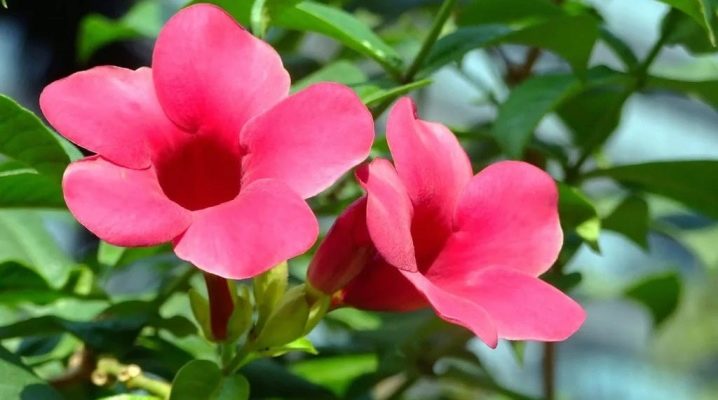
Allamanda is one of the most beautiful flowering plants, which has, in addition to magnificent decorative, also medicinal properties. Frost intolerance makes it impossible to grow it in the outdoor conditions of our climate, but as an indoor or greenhouse flower, the plant feels quite comfortable.
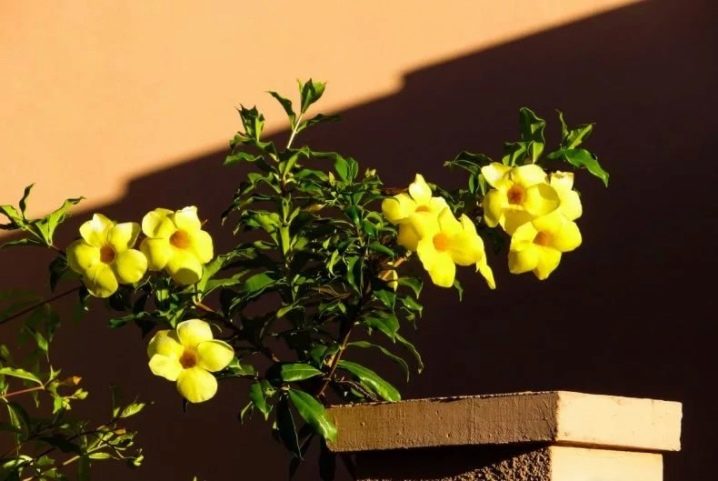
Description and features
Allamanda is an evergreen perennial that belongs to the Kutrov family. In fact, it is a liana-like or shrub plant with flexible shoots. Allamanda was brought from the American tropics. It should be noted such distinctive features as:
- the height of a shrub plant is up to 90 cm, a liana-like plant is slightly higher;
- pointed elongated leaves are paired, the color of juicy greenery, the surface is glossy, shines with shine;
- tubular inflorescences have 5 petals;
- flower size - from 8 to 12 cm;
- possible shades of flowering are quite deep, bright: pink, yellow, cream, white;
- inside the stems there is a milky white juice;
- plant poisonous everywhere
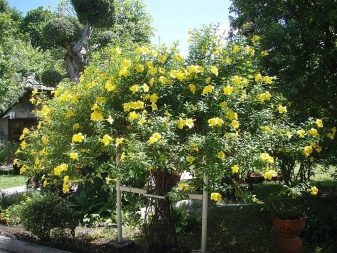
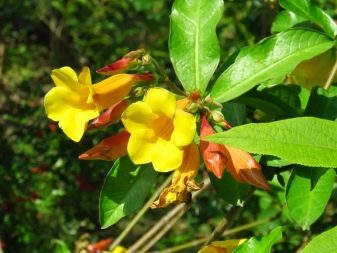
Varieties and varieties
There are quite a few species and hybrids of this representative of the flora. Florists identify several of the most common plants.
- Allamanda Terry The appearance of the inflorescence resembles a rose. The curled petals have a pronounced double structure, are not smooth, with waves along the edges.
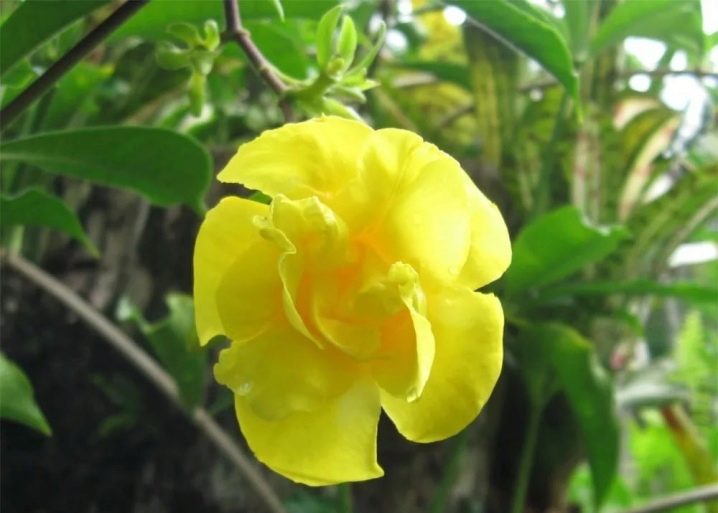
- Allamanda is a laxative. Quite a common species, curls, can grow very high, up to several meters. Naked, with fluff only at the bottom of the shoots, elongated oval foliage. Large leaves. The bloom is yellow with a golden tint and a snow-white base, they have a tubular appearance. In cultivation, it has many varieties.

- Allamanda is noble. It is similar to the previous variety, but differs in lancet-shaped foliage and a reddish shade of shoots. The top of the leaves is sharp, the bottom is fluffy. The bloom is yellowish, large, with a pronounced subtle aroma.
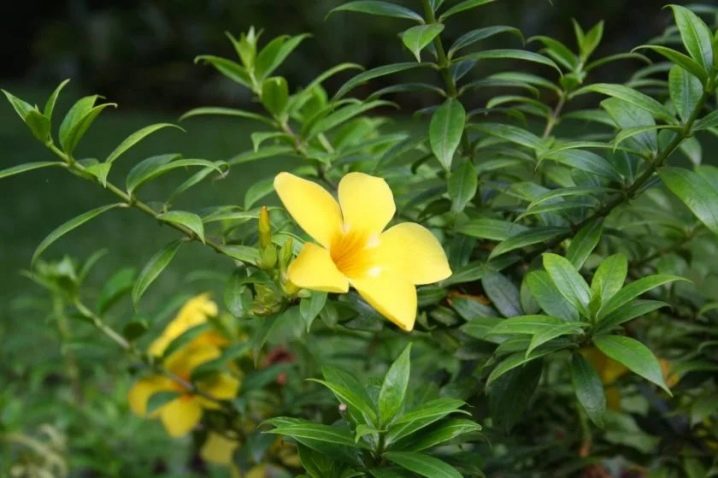
- Allamanda Henderson. It differs from its counterparts in appearance by its high growth rate and dense foliage, thickened type, with a leathery cover. Collected her foliage of 3 or 4 leaves. Blossoming orange with yellow and light streaks.
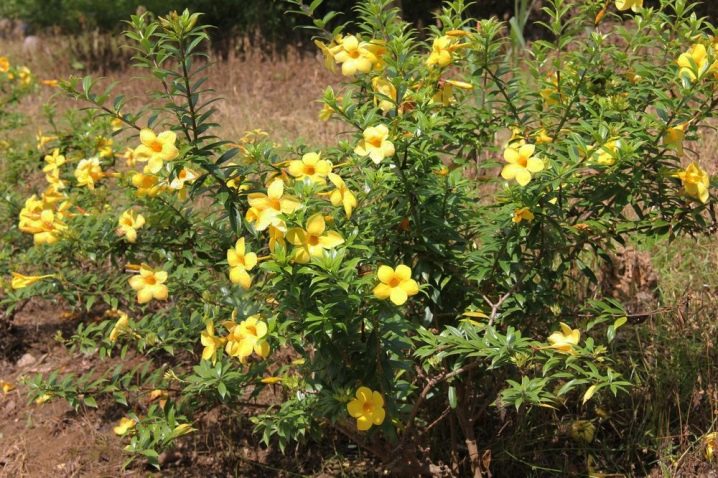
- Allamanda grandiflora. Differs in pink-shaped large flowering of lemon tone. The inflorescences are quite abundant, the leaves are lanceolate, the shoots curl.
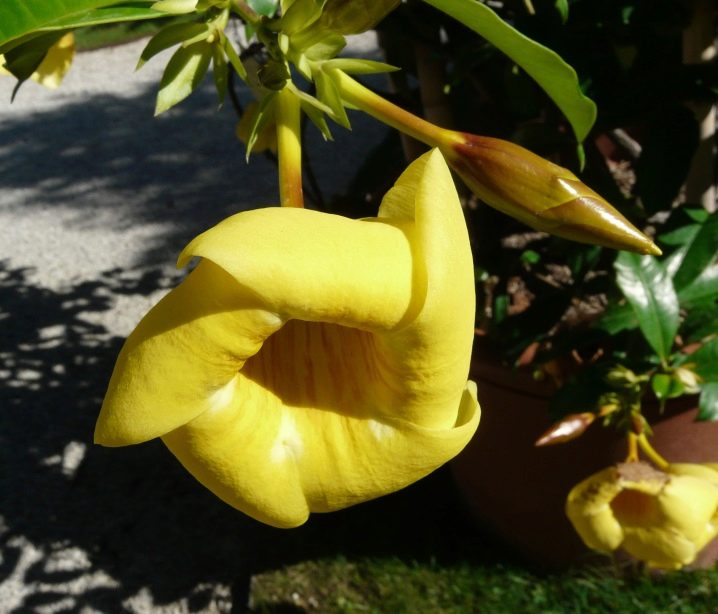
- Allamanda is yellow large-flowered. It grows slowly, the shoots twist so that they can be grown like ampelous plants. Leaves are oval, smallish. The bloom is bright yellow with a lemon tone.
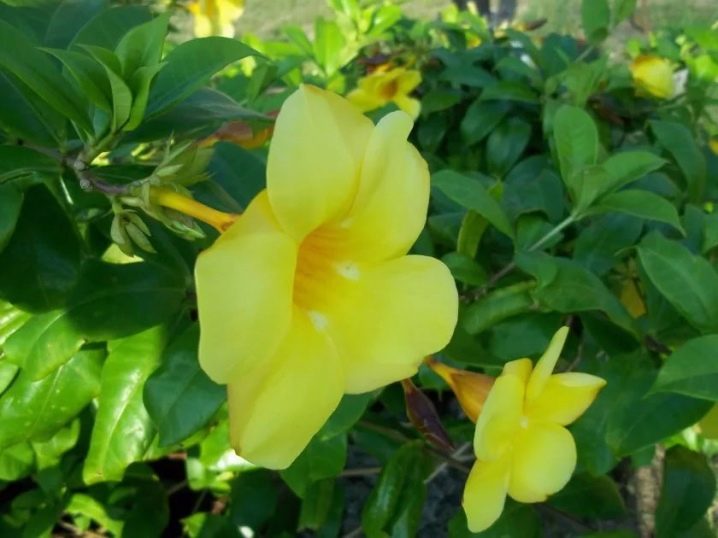
- Allamanda Shott. It is a fairly fast growing plant. Fluffy shoots, warty twigs. Broad leaves are formed by 3 or 4 leaves. Blossoming yellow-brown, striped.

- Allamanda is purple. Refers to slow-growing types. The foliage is elliptical, pubescent, connected by 4 leaves. The flowering is pale purple, the inflorescences are connected by 2-3 flowers.
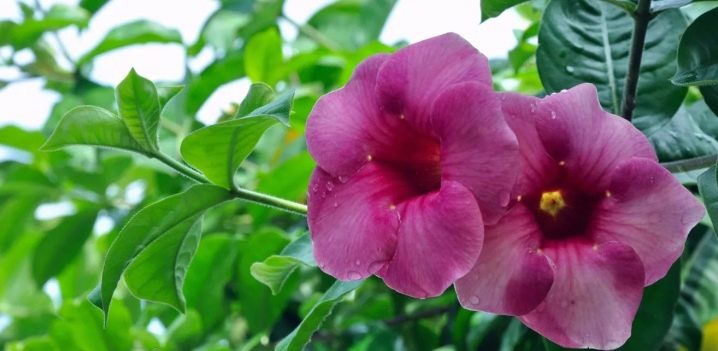
Flowering features
Home flowering of a capricious beauty requires painstaking work and care. A tropical guest requires warmth and very high humidity. If you have a winter garden or greenhouse equipped, then you will cope with the task. If you breed Allamanda in normal living conditions, additional care procedures will be required.
This does not mean that you need to give up trying, it just needs to be organized more carefully.
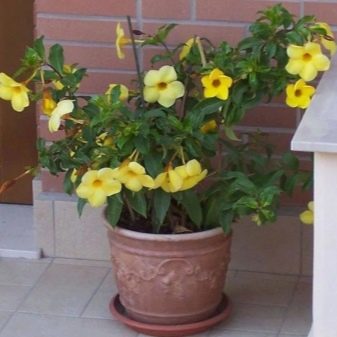

Home care
Before starting a plant, think over its location, lighting. Allamanda needs a lot of light, so the best option is a windowsill on the sunny side. Moreover, it should stand in close proximity to the glass, in no case do not remove the plant from the windows, it will quickly wither away.
A flower combines love for the sun with a fear of drafts, so be careful with airing.
The period of autumn and summer is the most comfortable for the plant, the air temperature in the room, as a rule, suits him. In the off-season, the temperature begins to decrease from +18 to +15 degrees in winter.


Moisturizing and feeding
Like many tropical plants, allamanda loves a lot of moisture during the growing season. Watering in the spring and summer should be abundant. It is necessary to ensure that the soil is not dry, but also not waterlogged, otherwise this will negatively affect the condition of the rhizome. Reduce watering gradually in the fall so that it becomes moderate by winter. During this period, the soil from above should have time to dry from watering to watering.
Air humidity is one of the main conditions for the healthy development of allamanda. It is desirable that there is a hygrometer in the room where it is located. It will allow you to monitor the moisture level, which should not fall below 60%. The plant loves water treatments, so spray the flower as often as possible in spring and summer. This can be done several times a day. In addition, periodically arrange a moisturizing procedure for a tropical beauty on a pallet filled with expanded clay, pebbles, moss or other humidifier. However, a container filled with water should not touch the bottom. In winter, you can spray the plant several times a week.
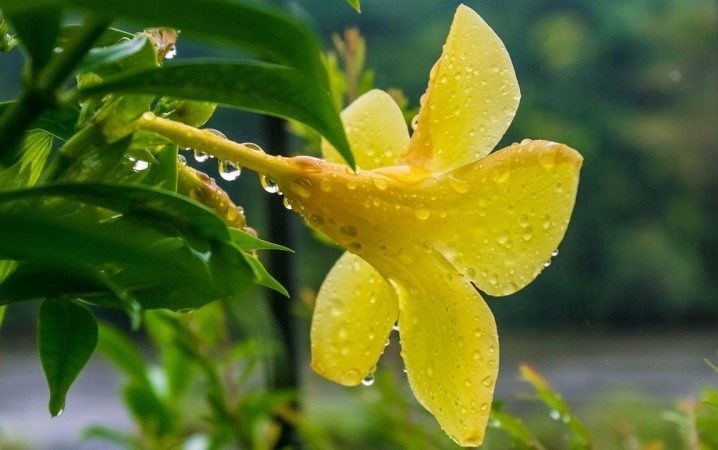
We must not forget about feeding the plant during the period of spring-summer growth.
It is necessary to buy any universal fertilizer in special markets and carry out the procedure once a month. Dilute the product according to the instructions. The pruning of the bush is done after it has faded. Shoots are cut in half, dried flowers are removed. Dry or weakened shoots are removed throughout the year.
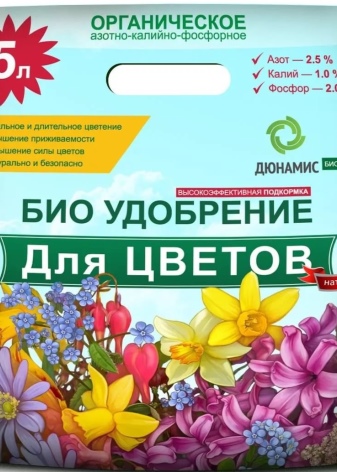
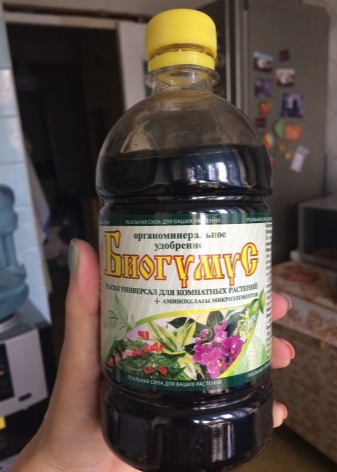
Transfer
The optimal time for transplanting a green pet is spring. A plant that has not reached maturity is subjected to this procedure once a year. A ripe shrub needs replanting once every 2 or 3 years. A very important point for planting and replanting is correctly selected soil. It should be loose, breathable and quite nutritious. The soil is purchased ready-made or prepared independently by combining the following components:
- part of woody land;
- part of the peat;
- two pieces of leafy land;
- two parts of humus earth;
- half of the sand.

All components are thoroughly mixed, after which the transplant takes place. If you have just bought a plant, it is advisable to immediately transfer it to nutrient soil. The landing algorithm is as follows:
- the pot should be slightly larger than the previous one;
- a drainage layer at the bottom is required, it is formed from any material: foam plastic, pebbles, broken brick, expanded clay;
- then a small part of the soil is poured;
- the plant is removed from the pot as carefully as possible, the earth is not completely removed from the roots;
- placed in a new container in the middle and covered with soil;
- the substrate next to the stem takes root;
- it is necessary to moisten the soil.
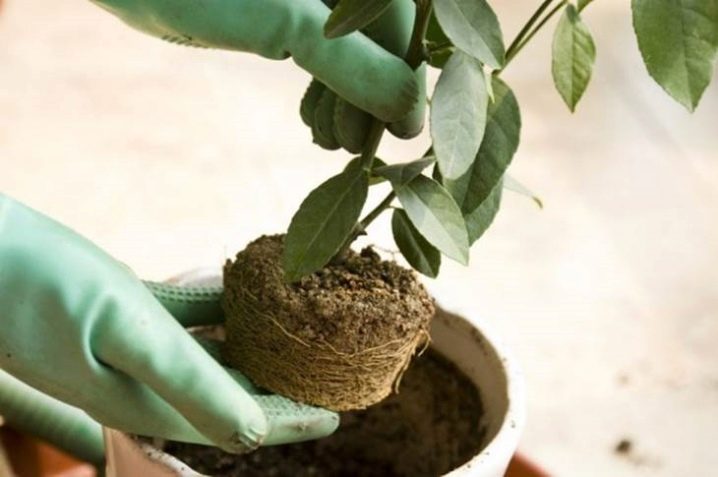
Diseases and pests
Despite the resistance to various types of diseases and insect attacks, it is necessary to pay attention to signs that indicate a violation of the health of the flower.
- If the neck of the rhizome begins to rot, this indicates overmoistening of the air and soil. It is necessary to carry out the treatment with the preparation "Fungicide" as soon as possible.
- When the shoots lengthen the stems are excessively stretched, and the foliage becomes pale and faded, you should pay attention to the lighting and feeding. It is likely that the flower lacks nutrients and light. It is necessary to feed the flower, as well as ensure its exposure to the sun.
- The flower began to shed its foliage - you should check whether he was overcooled, whether the watering is too intense. The plant also reacts to drafts in the same way.
- Insect attacks are quite rare, but they do happen. If you notice an invasion of a whitefly or spider mite, take medical measures. It is necessary to arrange a warm shower for the plant and treat it with special means - insecticides.
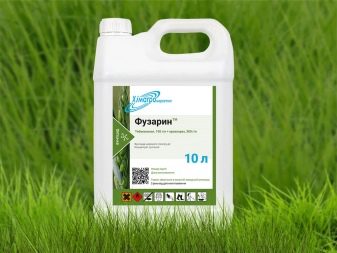

Reproduction
Seeds
The seed method algorithm looks like in the following way:
- the optimal start of sowing is February or March;
- first you need to carry out the treatment with a manganese solution and wash the seeds;
- they are planted completely dried;
- the soil should be light, planting is done no closer than 3 cm from each other;
- from above everything is sprinkled with sand and sprayed;
- be sure to place under polyethylene to create greenhouse conditions;
- provide a bright light of the diffused type and a temperature regime from +22 to +25 degrees;
- every day the seeds need to be aired, periodically moisten the soil;
- the latest sprout appearance is 6 weeks;
- after this, the seedlings should be without shelter, but this should be done gradually so that the shoots get used to it;
- as soon as there are at least 3 leaves per shoot, the plant is planted in a separate bowl and grown before planting in a pot
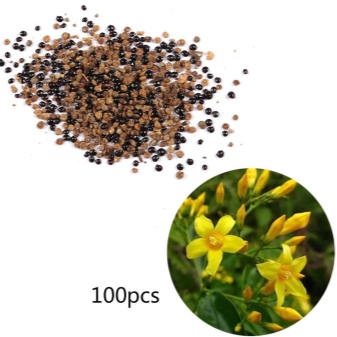
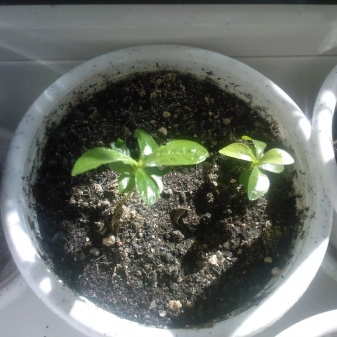
Cuttings
Cuttings are carried out with shoots cut in the spring, of a woody look. The main the rules of this method are as follows:
- choose cuttings 10 cm long;
- flower growers recommend treatment with stimulants: succinic acid solution, "Heteroauxin", "Kornevin" or "Zircon";
- prepare a mixture of soil from peat and sand, plant a cutting;
- place on top with the bottom of the cut plastic bottle;
- make sure that the lighting is diffused, the temperature is kept within + 22– + 25 degrees;
- ventilate the cutting every day, moisten the soil regularly;
- the appearance of foliage signals that rooting has occurred;
- can be safely planted in a separate container.
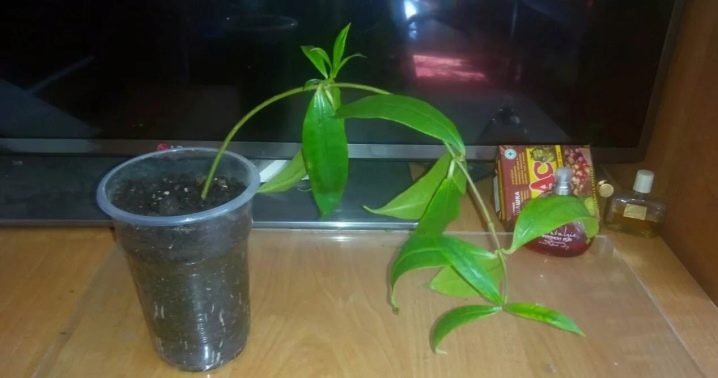
For more information on Allamand, see the next video.























The comment was sent successfully.